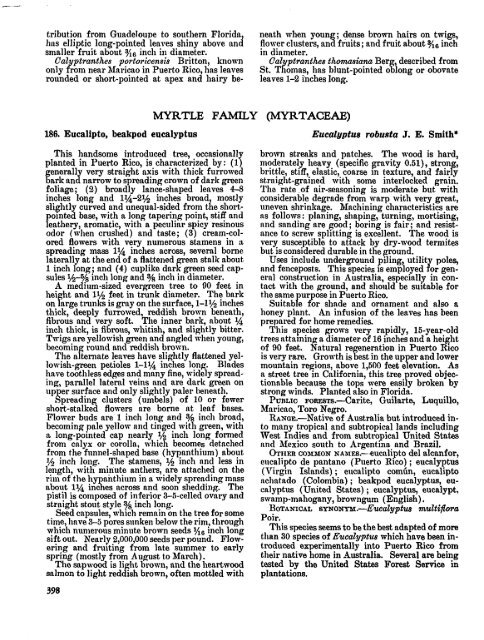Common Trees of Puerto Rico and the Virgin Islands
Common Trees of Puerto Rico and the Virgin Islands
Common Trees of Puerto Rico and the Virgin Islands
Create successful ePaper yourself
Turn your PDF publications into a flip-book with our unique Google optimized e-Paper software.
tribution from Guadeloupe to sou<strong>the</strong>rn Florida,<br />
has elliptic long-pointed leaves shiny above <strong>and</strong><br />
smaller fruit about inch in diameter.<br />
Ca2yptran<strong>the</strong>s portoricensis Britton, known<br />
only from near Maricao in <strong>Puerto</strong> <strong>Rico</strong>, has leaves<br />
rounded or short-pointed at apex <strong>and</strong> hairy be-<br />
186. Eucalipto, beakpod eucalyptus<br />
MYRTLE FAMILY<br />
a<br />
neath when youn ; dense brown hairs on twigs,<br />
flower clusters, an fruits; <strong>and</strong> fruit about 9/16 inch<br />
in diameter.<br />
Cal ptran<strong>the</strong>s thmasiana Ber described from<br />
St. ~fornomas, has blunt-pointed o%long or obovate<br />
leaves 1-2 inches long.<br />
Eucal~ptus robusta J. E. Smith*<br />
This h<strong>and</strong>some introduced tree, occasional1 brown streaks <strong>and</strong> patches. The wood is hard,<br />
planted in <strong>Puerto</strong> <strong>Rico</strong>, is characterized by : (17 moderately heavy (specific pavity 0.51), strong,<br />
enerall very straight axis with thick furrowed brittle, stiff,. elastic, coarse in texture, <strong>and</strong> fairly<br />
fark aninarrow to spreading crown <strong>of</strong> dark green straight-grained with some interlocked grain.<br />
fol~age; (8) broadly lance-shaped leaves 4-8 Tho rate <strong>of</strong> air-seasoning is moderate but with<br />
inches long <strong>and</strong> 1%-2% inches broad, mostly considerable degrade from warp with very great,<br />
slightly curved <strong>and</strong> unequal-sided from <strong>the</strong> short- uneven shrinkage. Machining characteristics are<br />
polnted base, with a long tapering point, stiff <strong>and</strong> as follows: planing, shaping, turning, mortising,<br />
lea<strong>the</strong>ry, aromatic, with a peculiar spicy resinous nnd s<strong>and</strong>ing are good ; boring is fair ; <strong>and</strong> resistodor<br />
(when crushed) <strong>and</strong> taste; (3) cream-col- ance to screw splitting is excellent. The wood is<br />
ored flowers with very numerous stamens in :L very susceptible to attack by dry-wood termites<br />
spreading mass 1% inches across, several borne but is considered durable in <strong>the</strong> ground.<br />
laterally at <strong>the</strong> end <strong>of</strong> a flattened green stalk about Uses include underground piling, utilit poles,<br />
1 inch long; <strong>and</strong> (4) cuplike dark p n seed cap- <strong>and</strong> fenceposts. This species is employed ! or gensules<br />
%-% inch long <strong>and</strong> 3/8 inch in diameter. era1 construction in Australia, especially in con-<br />
A medium-sized evergreen tree to 90 feet in tact with <strong>the</strong> ground, <strong>and</strong> shoald be suitable for<br />
hei ht <strong>and</strong> 11/2 feet in trunk diameter. The bark <strong>the</strong> same urpose in <strong>Puerto</strong> <strong>Rico</strong>.<br />
on F arge tmnks is gray on <strong>the</strong> surface, 1-1Y2 inches Suitab P e for shade <strong>and</strong> ornament <strong>and</strong> also a<br />
thick, deeply furrowed, reddish b m beneath, honey plant. An infusion <strong>of</strong> <strong>the</strong> leaves has been<br />
fibrous <strong>and</strong> very s<strong>of</strong>t. The inner bark, about l/s prepared for home remedies.<br />
inch thick, is fibrous, whitish, <strong>and</strong> slightly bitter. This species grows very rapidly, 15-year-old<br />
Twigs are yellowish green <strong>and</strong> angled when young, trees attaining a diameter <strong>of</strong> 16 inches <strong>and</strong> a height<br />
becomin round <strong>and</strong> reddish brown.<br />
<strong>of</strong> 90 feet. Natural regeneration in <strong>Puerto</strong> RICO<br />
The a f tsrnate leaves have slightly flattened yel- is very mre. Growth is best in <strong>the</strong> up er <strong>and</strong> lower<br />
lowish-green petioles 1-1s inches long. Blades mountain regions, above 1,500 feet e f evation. As<br />
have toothless edges <strong>and</strong> many fine, widely spread- a street tree in California, this tree roved objecing,<br />
parallel laternl veins <strong>and</strong> are dark green on tionable because <strong>the</strong> tops were easi ! y broken by<br />
lipper surface <strong>and</strong> only slightly paler beneath. strong winds. Planted also in Florida.<br />
Spreading clusters (umbels) <strong>of</strong> 10 or fewer PUBLI~ FO~STS.-Carite, Guilarte, Luquillo,<br />
short-stalked flom-ers are borne at leaf bases. Mnricao, Toro Negro.<br />
Flower buds are 1 inch long <strong>and</strong> 8/s inch broad, RANGE.-Native <strong>of</strong> Australia but introduced inbecoming<br />
pale yellolr <strong>and</strong> tinged m4th green, with to many tropical <strong>and</strong> subtropical l<strong>and</strong>s including<br />
n long-pointed cap nearly 1/2 inch long formed West Indies <strong>and</strong> from subtropical United States<br />
from cnlyx or corolla, which becomes detached nncl Mexico south to Argentina <strong>and</strong> Brazil.<br />
from <strong>the</strong> funnel-shaped base (hypanthium) about OTIIER COJEJZON ~~~~~s.-eucalipto del alcanfor,<br />
% inch long. The stamens, 1/2 inch nnd less in elicalipto de pantano (<strong>Puerto</strong> <strong>Rico</strong>) ; eucalyptus<br />
lcngt11, with minute an<strong>the</strong>rs, are attached on <strong>the</strong> (<strong>Virgin</strong> Isl<strong>and</strong>s) ; e~icalipto comtin, eucalipto<br />
rill1 <strong>of</strong> <strong>the</strong> hypanthium in a widely spreading mass nchatado (Colombia) ; beakpod eucalyptus, euabout<br />
1% inches across <strong>and</strong> soon shedding. The calyptus (United States) ; eucalyptus, eucalypt,<br />
pistil is composed <strong>of</strong> inferior 3-5-celled ovary <strong>and</strong> swamp-mahogany, browngum (English).<br />
straight stout style s/s inch long.<br />
Seed capsules, which remain on <strong>the</strong> tree for some<br />
BOTANICAL BYNONI~.-EUCLLZ~~~U~ mltifEOTa<br />
time, have 3-5 pores slinken below <strong>the</strong> rim, through<br />
Poir.<br />
which nunlerous minute brown seeds x6 inch long This species seems to be <strong>the</strong> best adapted <strong>of</strong> more<br />
sift out. Nearly 2,000,000 seeds per pound. Flow- than 30 species <strong>of</strong> Eucalyptus which have bean inering<br />
<strong>and</strong> fruiting from late summer to early troduced experimentally into <strong>Puerto</strong> <strong>Rico</strong> from<br />
spring (mostly from August to March).<br />
<strong>the</strong>ir native home in Australia. Several are being<br />
The sapwood is light bromn, <strong>and</strong> <strong>the</strong> heartmood tested by <strong>the</strong> United States Forest Service in<br />
salmon to light reddish bromn, <strong>of</strong>ten mottled with plantations.

















